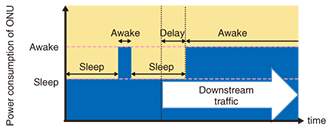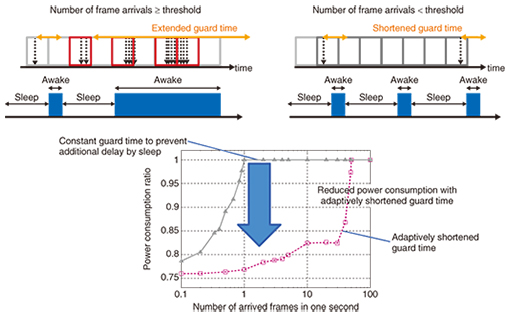 |
|||||||
|
|
|||||||
|
Feature Articles: Reducing the Environmental Burden of ICT Services Vol. 13, No. 3, pp. 34–39, Mar. 2015. https://doi.org/10.53829/ntr201503fa6 Issues and Solutions in Saving Energy of Optical Access Network EquipmentAbstractHigh-speed web browsing and high-resolution video content have become commonplace for end users with the help of recent high-performance user terminals. However, this results in continuous increases in both the use frequency and the volume of data traffic in the network, so an improvement in the capacity of the network is highly expected. However, the potential increase in power consumption of network nodes is a serious concern, as it is already at a significant level in current systems. Therefore, much effort is being focused around the world on finding ways to construct the next generation of network systems without increasing the power consumption. This article introduces issues specific to the optical access network, which represents a significant part of the power consumption in the entire network system, and describes the contribution of NTT Access Network Service Systems Laboratories in tackling these issues. Keywords: optical access network, power conservation, cyclic sleep 1. IntroductionThe architecture of the current 1-Gbit/s-capable FTTH (fiber-to-the-home) system, which is widely deployed for high-speed Internet services, consists of multiple network nodes, as illustrated in Fig. 1. The entire network can be roughly divided into two parts: the access network part, which is close to the end user, and the core network part. While the power consumption of one node in the core network is much larger than that of one node in the access network, the total consumption is greater in the access network because of the number of users each node is capable of serving [1]. Consequently, the per-user power consumption of the access network node is significantly larger. Therefore, tackling the issues related to the power consumption of the access network nodes will greatly contribute to reducing the total power of the entire network system.
2. Issues in power conservation of network nodesThere are several methods of reducing the power consumption of electrical devices, although some methods can affect the quality of service. Generally, the more a method reduces power consumption, the more adversely it affects network services. Moreover, some methods are only effective for specific types of nodes and are not effective on the others. For example, user terminals such as personal computers (PCs) can accurately detect the usage of the end user by directly receiving user operations through input interfaces such as a mouse click. With this precise information about user operations, user terminals can control the power saving functions according to the usage. Unlike this example, the intermediate network nodes must control the power saving functions by monitoring the network traffic and estimating the usage so as not to induce adverse effects on the user application. Another difficulty specific to the network nodes is their simplicity. The network nodes are basically equipped with only communication functions, which is different from the user terminals that have various rich functions. While user terminals can conserve power by turning off the unused functions, the network nodes’ method of saving power is limited to temporarily suspending the communication function when there is no traffic. Furthermore, the components that take a long time to wake up cannot be turned off because that could induce an additional delay, which also restricts the power saving of the network node. 3. Issues specific to optical access networksMoreover, there are further difficulties in power conservation of network nodes specific to optical access networks. The network nodes in the core network (e.g., servers and routers) accommodate traffic from a huge number of users. Because this aggregated traffic in the core network is expected to vary smoothly with time by the statistical multiplexing effect, effective power saving is also expected to be achieved at these nodes by reducing the number of active ports or packages of the processing unit. However, the traffic in the optical access network changes so drastically that it is difficult to estimate. Additionally, the nodes in the optical access network are often configured without redundancy such as that of a duplex system. Therefore, these power saving approaches are not applicable for optical access nodes that accommodate a small number of users. The appropriate power saving control technique for the optical access network should be able to precisely turn components on and off taking the bursty traffic into account. 4. Characteristics of traffic in the optical access networkWe focus here in particular on Internet traffic via an optical access network because the other traffic generated by VoIP (Voice over Internet protocol) and IPTV (Internet protocol television) services can be logically distinguished from Internet services, and it is easier to determine whether they are in use. While the amount of downloaded data from the Internet has been increasing year after year, it is much smaller than the potential capacity that the optical access network offers if we take unused time into account. For example, the most frequent value of the traffic volume in 2014 was reported to be 28 MB/day uploaded and 447 MB/day downloaded by one user [2]. Under the assumption that these data could be transferred in bulk, the upload and download would be completed in less than 4 s with an ideal 1-Gbit/s network. In theory, this indicates that most of the time in a day could be considered as resting time for the network nodes, as they do not have to transmit or receive user data. In fact, however, the access nodes have to control the timing to apply power saving functions in order not to induce adverse effects on the user experience. 5. Effect of suspending communication functionsSpecifically, the adverse effect induced by suspending the communication function of the access nodes is additional delay of the head packets, which are part of the packets successively generated by an application. It used to take several minutes for a PC to wake up from standby mode, so the head packets had to wait for the suspended devices to wake up. Because the actual delay would differ according to which components were suspended, we introduced sleep modes based on the standardized optical network unit (ONU) power saving of IEEE (Institute of Electrical and Electronics Engineers) Standard 1904.1-2013 [3]. There are two representative sleep modes, namely transmitter (Tx) sleep, which suspends the optical transmitter, and transceiver (TRx) sleep, which suspends the optical transceiver on the passive optical network (PON) side. 5.1 Tx sleepTx sleep is designed to suspend the functionalities in relation to the upstream data transmission of the ONU. Because the ONU has an Ethernet port on the user network interface (UNI) side, the ONU can immediately wake up by detecting the upstream input to the UNI even while the ONU turns off the optical transmitter on the PON side. The PON linkage between the ONU and the optical line terminal (OLT) at the central office is not disconnected by the timeout unless the ONU suspends the optical transmitter for a long time with no packet transmission. Therefore, the additional delay in applying Tx sleep would be limited to almost the same length of time as required to wake up the optical transmitter of the ONU regardless of the sleep duration while the sleep duration is less than 1 s (Figs. 2 and 3).
5.2 TRx sleepIn contrast, TRx sleep is designed to further suspend the functionalities in relation to the downstream data reception of the ONU. To detect the notification of downstream data arriving at the OLT, the ONU has to periodically turn on the optical transceiver. Therefore, the additional delay in TRx sleep would be lengthened according to the period in the worst case, even if the wakeup time of the transceiver is short (Figs. 4 and 5).
6. Controlling the effect of ONU sleepMore effective power saving can be expected with TRx sleep than with Tx sleep by suspending a wider range of components in the ONU. Meanwhile, a conservative control that does not adversely affect the user application is necessary for TRx sleep. A typical control is to set a guard time so that the sleep period does not start for a certain period of time after a packet arrives, which would be effective for continuous packet generation while the application was in use. However, a few types of traffic flow are automatically generated in the access network even while the user is not actively using an application. For example, some protocols periodically send packets to each other in order to detect a fault quickly in the communication path. In these circumstances, the ONU will not start the sleep during the guard time, which is constantly extended by the periodic arrival, and the effectiveness of power conservation would be significantly constrained. Therefore, we have proposed an adaptive control method for TRx sleep that enables the length of the guard time to be changed (Fig. 6). When the number of arrived packets is so small that it can be assumed to be automatically generated traffic consisting of keep-alive messages, the controller reduces the guard time. When the number of arriving packets exceeds the threshold, the ONU extends the guard time to prevent the additional delay that directly affects the user experience, assuming that the user is actively using the applications. We confirmed in experiments that these proposed methods can reduce the average power consumption by 20 percent at maximum when the automatic keep-alive messages are frequently generated.
7. Future directionIn an era of IoT (Internet of things), where a variety of sensors would automatically communicate with the servers more frequently even without any human operations, the traffic characteristics would experience a drastic change. Because there is a close relationship between the power saving of network nodes and network traffic, especially in an optical access network, as introduced in this article, we have to pay constant attention to traffic trends in order to develop energy efficient network systems. References
|
|||||||









